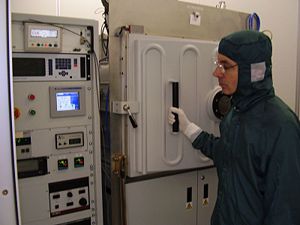Specific Process Knowledge/Thin film deposition/Wordentec: Difference between revisions
| Line 52: | Line 52: | ||
[http://labadviser.danchip.dtu.dk/index.php/Specific_Process_Knowledge/Thin_film_deposition/Deposition_of_Gold#Studies_of_Au_deposition_processes_in_the_Wordentec| Temperature and roughness studies of Au deposition processes in the Wordentec] | [http://labadviser.danchip.dtu.dk/index.php/Specific_Process_Knowledge/Thin_film_deposition/Deposition_of_Gold#Studies_of_Au_deposition_processes_in_the_Wordentec| Temperature and roughness studies of Au deposition processes in the Wordentec] | ||
While E-beam evaporation, some materials like Au and Al can affect the underlying layers, especially thin resists like E-beam sensitive can get exposed or even change the topography when creating thin films. Cases of releasing bubbles of the solvent will create a crater like surface on some materials. In most cases this is only affecting the areas containing resist, hence liftoff is often easier and the areas without resist will have good adhesion. | |||
===Thermal evaporation materials=== | ===Thermal evaporation materials=== | ||
Revision as of 16:08, 19 February 2018
Feedback to this page: click here
Wordentec QCL 800

The Wordentec is a machine for:
- Deposition of metal through E-beam deposition
- Deposition of metal through thermal evaporation
- Deposition of materials through DC sputtering
- Cleaning of samples before deposition through Argon RF sputter clean
The Wordentec is designed to deposit on 1-6 samples in sequence, samples of a size up to 6" in diameter. Adaptors exist for deposition on 2", 4" and 6" wafers, but deposition is possible on samples of almost any size and shape, as long as they do not exceed the size of a 6" substrate. The Wordentec supports either single sample deposition on each sample or batch deposition on six wafers in sequence. It is possible to freely combine processes from the machines different sources.
The user manual, quality control procedure and results, user APV, technical information and contact information can be found in LabManager:
Process information
The metals available for E-beam evaporation and their standard deposition rates are:
| Metal | Deposition rate [Å/s] |
|---|---|
| Titanium (Ti) | 10 |
| Chromium (Cr) | 10 |
| Aluminium (Al) | 10 |
| Nickel (Ni) | 10 |
| Platinum (Pt) | 10 |
| Gold (Au) | 10 |
Temperature and roughness studies of Au deposition processes in the Wordentec
While E-beam evaporation, some materials like Au and Al can affect the underlying layers, especially thin resists like E-beam sensitive can get exposed or even change the topography when creating thin films. Cases of releasing bubbles of the solvent will create a crater like surface on some materials. In most cases this is only affecting the areas containing resist, hence liftoff is often easier and the areas without resist will have good adhesion.
Thermal evaporation materials
We currently have Aluminium, Silver and Germanium available to deposit through thermal evaporation.
Sputter materials
It is possible to sputter deposit almost any material, provided that it is possible to deposit with DC sputtering. The materials available currently are:
- TiW alloy (10%/90% by weight)
- Aluminium (Al)
- Chromium (Cr)
- Silver (Ag)
- Titanium (Ti)
- Silicon (Si)
- NiV alloy
More information about deposition rates and surface roughness can be found by clicking on the different elements.
| Purpose | Deposition of metals |
|
|---|---|---|
| Performance | Film thickness |
|
| Deposition rate |
| |
| Process parameter range | Process Temperature |
|
| Process pressure |
| |
| Substrates | Batch size |
|
| Substrate material allowed |
| |
| Material allowed on the substrate |
|
* For thicknesses above 200 nm permission is required.
Quality control (QC) for Wordentec
| Quality control (QC) for Wordentec | ||||||||||||||||||||
Thicknesses are measured in 5 points with one of the Dektak instruments. |
